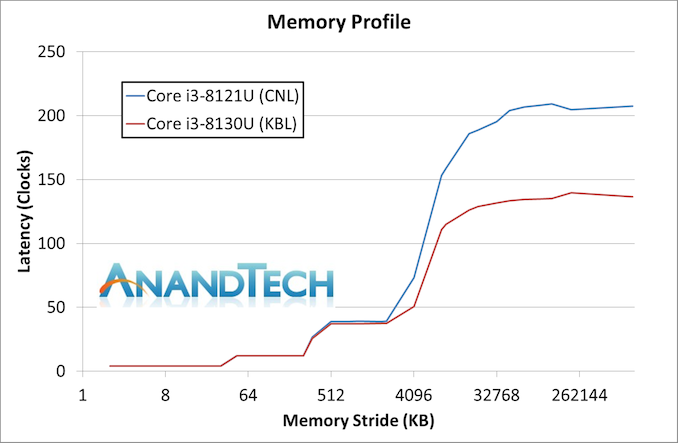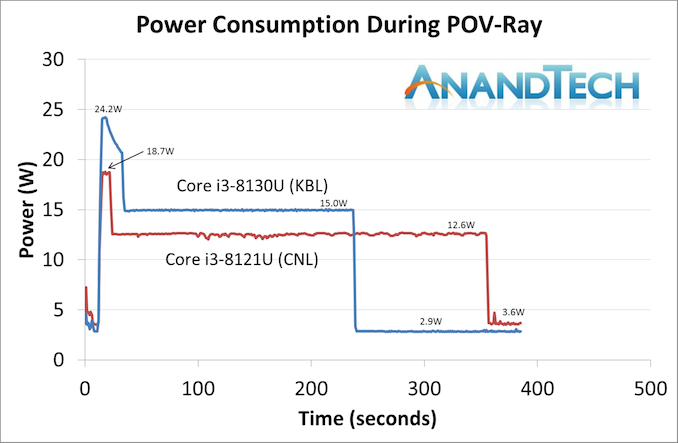Intel's 10nm Cannon Lake and Core i3-8121U Deep Dive Review
by Ian Cutress on January 25, 2019 10:30 AM ESTCPU Performance: Memory and Power
Memory
With the same memory setup as the standard Skylake-style core, without any other improvements, we should expect Cannon Lake to perform exactly similar. Here’s a recap of the memory configuration:
| Memory Comparison | ||
| Skylake Desktop | Cannon Lake | |
| L1-D Cache |
32 KiB/core 8-way |
32 KiB/core 8-way |
| L1-I Cache |
32 KiB/core 8-way |
32 KiB/core 8-way |
| L2 Cache |
256 KiB/core 4-way |
256 KiB/core 4-way |
| L3 Cache |
2 MiB/core 16-way |
2 MiB/core 16-way |
| L3 Cache Type | Inclusive | Inclusive |
For this test we put our Cannon Lake and Kaby Lake processors through our Memory Latency Checker test. Both systems had turbo modes disabled, forcing them to run at 2.2 GHz for parity and a direct microarchitecture comparison.
In this instance we see very little different between the two through the caches of the chip. Up to about 2MiB, both chips perform practically identical. Beyond this however, going out to main memory, there is a big discrepancy between the Kaby Lake and the Cannon Lake processor. In essence, accessing Cannon Lake main memory has an additional 50% latency.
At first we thought this was a bug. For both systems to have dual channel memory and running DDR4-2400, something had to be wrong. We double checked the setups – both systems were running in dual channel mode, giving the same memory bandwidth. The Cannon Lake processor was running at DDR4-2400 17-17-17, whereas the Kaby Lake system was at DDR4-2400 16-16-16 (due to memory SPD differences), which isn’t a big enough change to have such a big difference. The only reason we can come up with is that the memory controller on Cannon Lake must have additional overhead from the core to the memory controller – either a slower than expected PLL or something.
Power
Measuring the power of these thermally limited systems is somewhat frustrating in that we are at the whims of the quality of silicon at play. Bad silicon can get hotter faster, causing thermal throttling, or it depends on how the systems are set up for the peak power numbers. We use AIDA’s power monitoring tool to give us the power numbers for the CPUs during our POV-Ray test.
If you saw our How Intel Measures TDP article, you may be familiar with the concept of Power Limits. Intel processors have several power limits set in firmware – these values are set by the system manufacturer, and Intel provides ‘guidelines’. The two key values are Power Limit 1 (PL1), which describes a steady state scenario, and Power Limit 2 (PL2) which describes a turbo scenario. The reason why the system manufacturer gets control of these is because they might put a high wattage processor into a small form factor system, and need to manage performance – this is why we sometimes see a Core i7 be outperformed by a Core i5 in the same system design.
In most cases, PL1 is set to the TDP of the processor – in this case, it should be 15W. As shown on the graph above, this is true for our Core i3-8130U system, which shows a steady state power consumption of 15.0W. The Cannon Lake processor however only peaks at 12.6W.
PL2, the turbo power of the processor, can also be determined. For the Kaby Lake processor, we see a peak of 24.2 W, while the Cannon Lake has a turbo only of 18.7 W. We see that the turbo time period for the Cannon Lake processor is also much shorter, leading to a PL1 / steady state power much sooner.
Part of this is because we are pitting the Cannon Lake laptop against the Kaby Lake mini-PC. That being said, the Cannon Lake laptop is a beefy 15.6-inch unit, and has cooling for both the CPU and the discrete RX540 graphics, which isn’t doing much during this test except showing a basic 2D display.
That is arguably a lot more cooling than the mini-PC provides, plus we are cooling it with additional fans. These settings are more a function of both Lenovo doing what it wants to in firmware that we can’t change, but also the chip as engineered.
We can also calculate some level of efficiency here. By taking the area under the graph and correcting for the base line power (2.9 W on KBL, 3.6 W on CNL), we can calculate the total power consumed during the test. We get the following:
- Core i3-8121U (CNL) consumes 867 mWh
- Core i3-8130U (KBL) consumes 768 mWh
So this means that Cannon Lake is slower in AVX2 frequency, consumes more power, and scores 25% less in POV-Ray (see previous pages). That’s damning for the design.
To further look into this data, we disabled the turbo modes on both processors and ran our POV-Ray workload adjusting the number of threads being loaded and then measured the power consumption. In this scenario we are running at the same frequency, measuring the steady state power, and are thus at the whims of both the voltage set on both processors and the efficiency. Our tool also lets us measure the power of just the cores, so we’ll plot core power against threads loaded.
If this graph was the definitive graph, it shows that Cannon Lake is vastly inefficient (at 2.2 GHz) compared to Kaby Lake.














129 Comments
View All Comments
danwat1234 - Friday, January 25, 2019 - link
Intel ice Lake for performance laptops should be out by 2019 christmas. Then we will see if there are any IPC improvements in this new architecture. Probably not much...BigMamaInHouse - Saturday, January 26, 2019 - link
I think that Intel need 10nm for Data-centers for higher core count and profit, and their production focus will be on this area and not consumer desktop PC's.I don't see 9700K/9900K 10nm competitor until 2020.
Santoval - Monday, January 28, 2019 - link
Sunny Cove and Willow Cove are intermediate designs until the release of Ocean Cove, the "brand new" CPU architecture Jim Keller was hired to lead the design of. Since Ocean Cove has not yet appeared in Intel's schedule it either means that it will not be ready before at least 2022 or Intel is just being secretive.Or it might just be Golden Cove. Since Golden Cove will apparently be Intel's next new design, if the it is not actually Ocean Cove, then Ocean Cove will not be released until 2023 at the earliest (at 7nm). That's because Intel has never released two new designs one after the other without an optimization in-between. It's also possible that Intel will just "pull a Skylake" and rather than use a new design for Golden Cove they will just.. re-optimize it. In that case Ocean Cove should be released in 2022, right after Golden Cove.
Trevor08 - Friday, February 1, 2019 - link
For intel's sake (and ours), I hope they're working furiously on quantum CPU's.peevee - Monday, February 4, 2019 - link
So far, quantum is looking like a dead end. Maybe for specialized coprocessors in cryo environments in 10 years, but not for general-purpose computing AT ALL.There are much better, actually realistic directions for general-purpose computing on non-Von Neumann architectures, and that is where the future lies now that Moore's law is firmly dead and buried.
HStewart - Saturday, January 26, 2019 - link
There is not release information about desktops on Ice Lake. But I would not doubt that Ice Lake on desktop at that time. It going to be fun to compare new laptops and even desktops at that time.But keep in minor to Intel desktop market is a minor market and once performance is up, I would not doubt we will not see any difference in desktop vs mobile chips
Santoval - Monday, January 28, 2019 - link
We don't know how well Ice Lake / Sunny Cove will perform, but no matter how good it performs AMD will still have a market lead of 6 to 7 months (assuming a release of Zen 2 based Ryzen CPUs in May or June and an Intel HVM release of Sunny Cove in December).This assumes that Intel does not screw up again and moves back the launch of Sunny Cove into 2H 2020, which would be frankly catastrophic, at least for their client wing. Their 14nm process has been milked dry, they can no longer extract any more performance from it.
James5mith - Friday, January 25, 2019 - link
"This is an M.2 module, which means it could be upgraded at a later date fairly easily."No, you can't. Lenovo only lets wifi/bluetooth cards with their custom firmware in their systems. If you boot the system with a standard (say Intel) wifi card, it refuses to boot.
That's the reason I stopped buying lenovo laptops despite liking their build and design.
jeremyshaw - Friday, January 25, 2019 - link
They've stopped doing that since about ~2 years ago.levizx - Saturday, January 26, 2019 - link
Welcome to 2015.